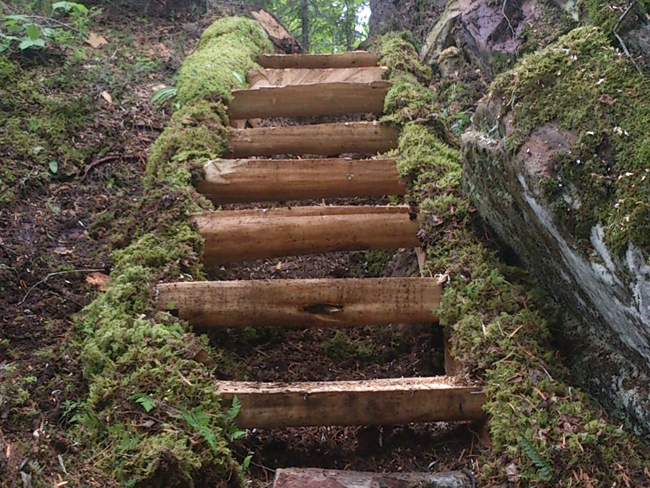Wikwemikong Tourism furthers training with hiking trail development
WIKWEMIKONG – The Tourism Department of the Wikwemikong Reserve is diversifying its service portfolio, providing training and trail development services to other First Nations and municipalities in Ontario.
The trail development activities eventually turned into hybrid contracting which means WUIR provides the technical expertise in the design and layout of a community’s trail system and their staff trains the local group’s crew and assists in the construction of the proposed trail.
WDC just completed 2.5kms of a hybrid trails training with the Pic River First Nation. Training commenced in the community of Pic River with their band members for construction of the hand built trail. The WDC Trail team will be assisting Sheshegwaning First Nation this summer with upgrades to the existing Nimkee Trail.
“Pic River First Nation is a progressive community looking to expand our economic potential,” said Elizabeth Michano, Pic River Economic and Community Development Director. “With a recent study that we conducted in regards to eco-tourism in our area and Aboriginal tourism we decided to revitalize an old project that was started back in 2006 to develop a coastal trail between Pic River First Nation and the township of Marathon. I was put in contact with Luke Wassegijig from Wikwemikong to come to our area to work with us and train my trail crew on how to develop and maintain a walking trail system. We are hoping to attract the tourists that are currently accessing the trail systems through Pukaskwa National Park. This project has provided my trail crew with new skills and experiences that will be required to complete and enhance the rest of our trail right through to Heron Bay and then onto Marathon. We are looking forward to completing this trail system as we have had inquiries about the trail already. “
The trails are built focusing on three main areas; sustainability, safety and user experience.
“Our trail team understands the importance of designing a trail system that maximizes the First Nations economic potential while ensuring our inherent responsibility to environmental stewardship,” said Luke Wassegijig, Tourism Coordinator, who has been employed for the past seven years with the Wikwemikong Development Commission (WDC).
The trail training initiative consists of both in-class theoretical training in GPS design and layout and principles of sustainable trail development. From these initiatives 20 Wikwemikong band members were hired by the Tourism group, some of which are continuing their employment from last year’s trails development.
This trails project is due to the assistance provided since 2009 from the support of the Wii-ni n’guch tood Local Delivery Mechanism (LDM) in Wikwemikong. The LDM is able to fund training projects such as the hiking trails through co-funding derived from Wikwemikong’s Aboriginal Skills, Employment and Training Agreement (ASETA) with Human Resource Skills Development Canada (HRSDC).
“Partnerships and local decision-making are key to these successful projects,” said Colleen Wassegijig, WLDM Coordinator.
This tourism driven initiative was developed as a demand generator/attraction for the WUIR and it capitalizes on economic development opportunities that exists in adventure tourism. The hiking trails within Wikwemikong, named ‘Bebamikawe Memorial Trail’, were opened June 29th of 2012. This trail spans 14kms and is promoted as being Manitoulin Island’s only professionally built trail system.
“As a leader in trail development Wikwemikong has developed 14kms of professionally built trails in Wikwemikong that attracted over 3,500 users in its opening year,” said Luke. “The trail was also developed as a health promotional tool by incorporating a 1.5km fitness trail complete with outdoor fitness equipment intended for the WUIR band membership, which is also open to all.”
Why First Nations tourism? Well, according to the statistics provided at the recent 8th Annual Great Spirit Circle Trail Tourism Conference held at the new Manitoulin Hotel in May 2013 tourists are seeking out more authentic experiences, which First Nations uniquely have to offer, hiking trails to explore First Nations land being one option.
As their skills were further developed Wikwemikong Tourism developed partnerships with the Georgian Bay Coast Trail (GBCT) and several First Nations along Highway 69 to determine viability of a trail system being built in this region of Ontario.
The GBCT system is a First Nations led economic development project, involving Wikwemikong, Henvey Inlet, Magnetewan and the Shawanaga First Nations.
“From the coast trails perspective we would not have any progress in developing the trail without the First Nations, they’re our partners, they have a lot to contribute,” said Laura Peddie, Partnership Coordinator, with the GBCT, a non-profit group based out of Parry Sound. “It is going to be on their land, it is very much their trail.”
“The board members of the GBCT wanted a trail that showcased Georgian Bay by foot as there were not a lot of foot options,” said Peddie. “It was originally going to be developed only up the French River then Luke met with one of our board members who expressed interest in expanding it over to the Point Grondine area.”
The GBCT trail is proposed to be a pay per use trail system modeled after the west coast trail system built on Vancouver Island.
“When the partner First Nations visited the west coast trail on Vancouver Island in September 2012 we knew we could also have this here in Ontario as we have many scenic areas to highlight for outdoor enthusiasts,” said Luke.
Once fully completed, the GBCT trail will span over 200kms through forested areas along the Georgian Bay coast. For full details on these project initiatives check out websites of: www.gbcoasttrail.com and www.wikydevcom.ca. For more information on WDC Trail Training initiatives call 705-859-3477.



